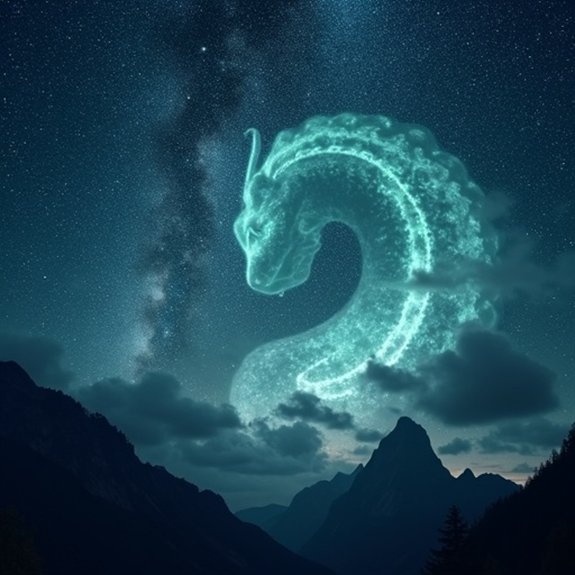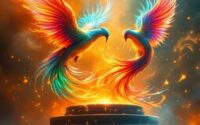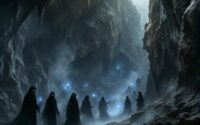The Legend of the Snake in the Sky
Throughout history, countless civilizations have gazed upward and spotted the same mysterious pattern—a massive serpent winding through the stars. They’ve named it differently, feared it, worshiped it, and built entire belief systems around its presence. Ancient stargazers didn’t just see random lights; they recognized something that fundamentally shaped their understanding of seasons, harvests, and destiny itself. But what made this celestial snake so universally significant across unconnected cultures remains unexplained.
Introduction

When ancient civilizations gazed at the night sky, they didn’t just see random points of light—they saw stories written in the stars. Among these celestial narratives, the snake constellation has captivated cultures across continents for millennia. Different societies’ve interpreted this serpentine pattern uniquely, weaving it into their mythologies and belief systems.
The snake’s presence in the heavens isn’t coincidental. Its sinuous form naturally emerges from the curved arrangement of stars, making it one of humanity’s most recognizable stellar patterns. From the Greeks’ Hydra to the Chinese Azure Dragon, serpent constellations’ve served as navigational guides, seasonal markers, and spiritual symbols. These sky serpents’ve influenced agricultural practices, religious ceremonies, and storytelling traditions, demonstrating how astronomical observations shaped early human civilization’s development and cultural identity.
Ancient Mesopotamian Serpent Mythology
Though serpents appeared throughout Mesopotamian cosmology, the constellation known as MUL.DINGIR.MUŠ held particular significance in Babylonian astronomy. This “divine snake” constellation corresponded to modern Hydra, stretching across the southern sky. Babylonian star catalogues from 1100 BCE documented its rising and setting times, linking them to agricultural cycles and flooding patterns.
The celestial serpent’s mythology intertwined with Tiamat, the primordial goddess of chaos who’d taken serpentine form in creation myths. Priests tracked MUL.DINGIR.MUŠ’s movements to predict seasonal changes and divine messages. They’d record observations on cuneiform tablets, noting when the snake’s head emerged above the horizon.
In Assyrian traditions, the sky serpent represented Nirah, messenger deity of Ištaran. Temple astronomers believed the constellation’s brightness variations signaled communications between earthly and divine domains.
Notable Cases or Sightings

How did ancient astronomers distinguish between mythological serpent constellations and actual phenomena in the night sky? They couldn’t always tell the difference. Chinese astronomers in 1054 CE documented what they called a “guest serpent” stretching across the heavens—now known as the Crab Nebula supernova. Medieval European chronicles describe “flying dragons” during meteor showers, particularly the Leonids of 1833.
The most intriguing case occurred in 1561 over Nuremberg, where witnesses reported serpentine shapes battling in daylight. Hans Glaser’s woodcut depicts these aerial phenomena as intertwining snakes. Modern researchers suggest atmospheric optical effects or auroral displays as explanations. Aboriginal Australian sky watchers have consistently identified the Rainbow Serpent in the Milky Way’s dark lanes for thousands of years, demonstrating how cultural interpretation shapes celestial observation.
Common Theories or Explanations
These historical accounts have sparked numerous scientific and cultural explanations for serpentine phenomena in the sky. Meteorologists often attribute snake-like formations to rare atmospheric conditions. Lenticular clouds can create undulating patterns that resemble serpents, while rope tornadoes produce sinuous shapes that twist through storm systems. Some researchers suggest that ball lightning or plasma formations might’ve generated the glowing, snake-like apparitions witnesses described.
Anthropologists propose different interpretations. They argue that ancient cultures projected archetypal symbols onto natural phenomena, transforming ordinary clouds or aurora displays into divine serpents. Optical illusions caused by temperature inversions can distort distant objects, creating the appearance of writhing forms. Additionally, some theorists believe migrating bird flocks, particularly when viewed at specific angles during sunset, produce serpentine silhouettes that observers misidentified as singular entities.
Frequently Asked Questions
How Can I Report a Snake in the Sky Sighting to Researchers?
They can’t report snake in the sky sightings to researchers since these are mythological phenomena from legends, not real events. Scientists don’t study legendary creatures, but they’d document unusual atmospheric phenomena through meteorological organizations instead.
Are There Any Documentaries or Films About the Sky Snake Phenomenon?
Several documentaries explore atmospheric phenomena that viewers interpret as sky snakes. “Atmospheric Beasts” (2009) examines unexplained aerial creatures, while “Sky Serpents: Mystery Above” (2015) investigates historical sightings. Independent filmmakers’ve also created short films documenting witness accounts.
What Equipment Is Best for Photographing Potential Sky Snake Appearances?
Photographers who’ve documented sky snake sightings recommend using telephoto lenses (300mm or longer), tripods for stability, and cameras with high ISO capabilities. They’ll need polarizing filters to reduce atmospheric haze and fast shutter speeds.
Do Any Modern Religions Incorporate Sky Serpent Beliefs Into Their Practices?
Several modern spiritual movements incorporate sky serpent beliefs, particularly neo-pagan and New Age groups. They’ve adopted rainbow serpent traditions from Aboriginal Australian spirituality and Mesoamerican feathered serpent deities like Quetzalcoatl into their contemporary practices.
Are There Support Groups for People Who’ve Witnessed Sky Snakes?
There aren’t formal support groups specifically for sky snake witnesses, but they’ll find communities in UFO forums, cryptozoology groups, and online paranormal discussion boards where people share similar unexplained aerial phenomena experiences without judgment.


